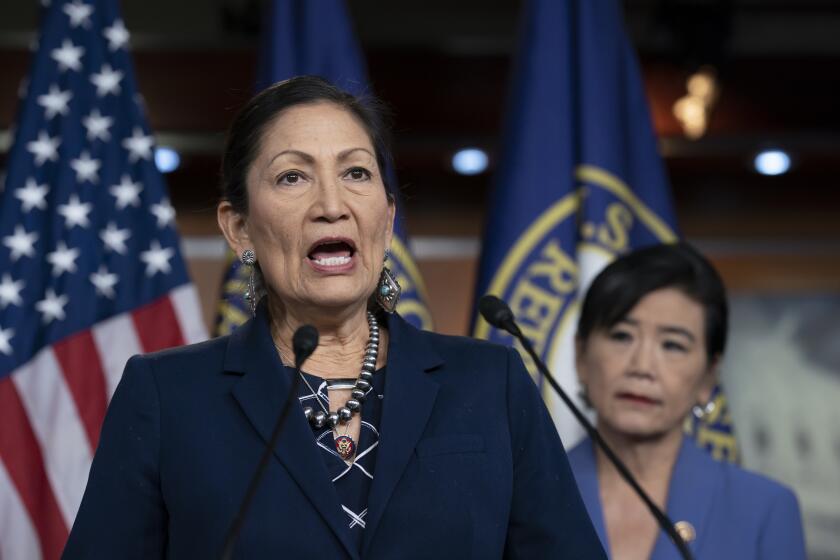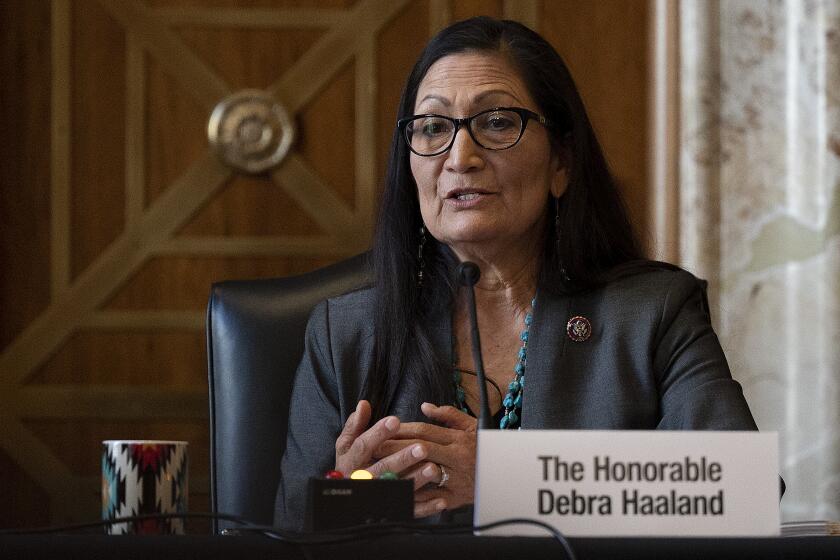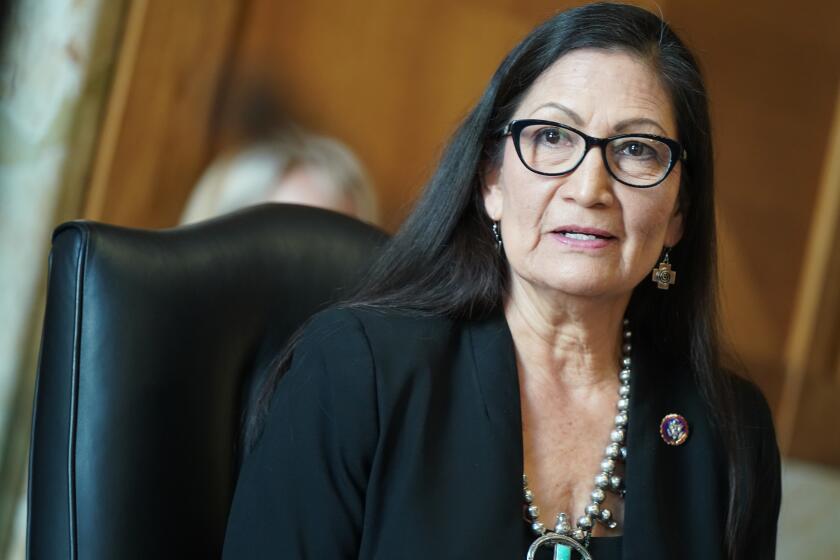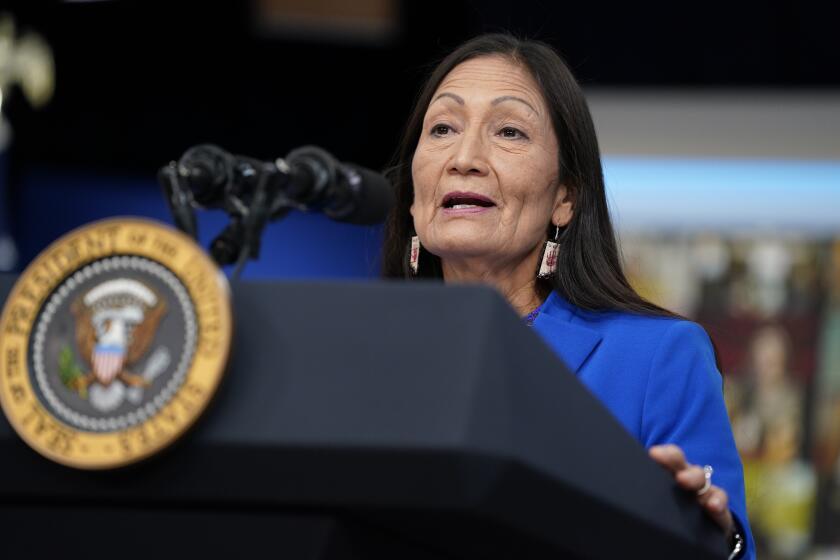Interior Secretary Deb Haaland reflects on tenure and tradition amid policy challenges
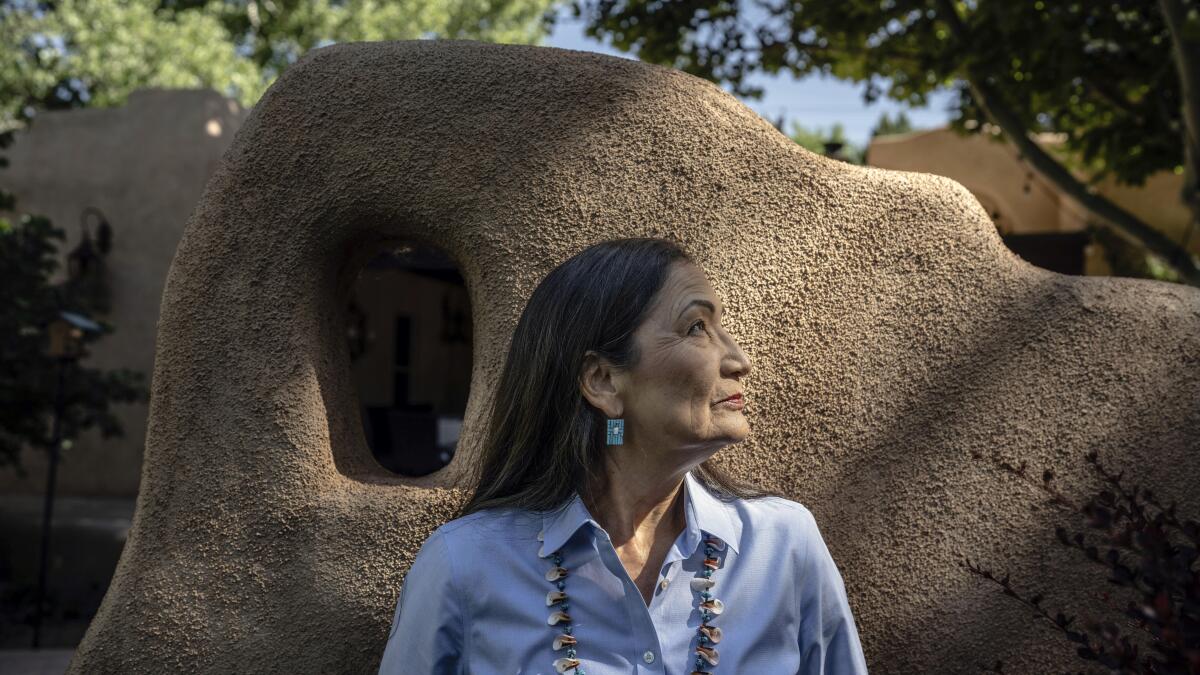
- Share via
ALBUQUERQUE — It was never about making history for Deb Haaland, but rather about making her parents proud.
She says she worked hard, putting herself through school, starting a small business to pay bills and eventually finding her way into politics — first as a campaign volunteer and later as the first Native American woman to lead a political party in New Mexico.
The rest seems like history. Haaland was sworn in as one of the first two Native American women in Congress in 2019. Two years later, she took the reins at the Interior Department, an agency whose responsibilities stretch from managing energy development to meeting the nation’s treaty obligations to 574 federally recognized tribes.
Haaland, the first Native American Cabinet member in the U.S., spoke to the Associated Press about her tenure leading the 70,000-employee agency that oversees subsurface minerals and millions of acres of public land.
The hardest part? Balancing the interests of every single American, she said.
“I might feel one way about an issue personally. It doesn’t mean that that’s the decision that’s going to be made,” said Haaland, 62, sitting in the shade of the towering cottonwood trees that line her backyard in Albuquerque. “There is a process, so I am dedicated to that. I really do want to find a balance.”
Deb Haaland would be first Indigenous Cabinet member, running the agency that oversees federal land and American Indian affairs.
Criticism of Haaland has mounted in recent weeks. Environmentalists slammed her department’s approval of the massive Willow oil project in Alaska, while a Republican-led U.S. House committee opened an investigation into ties between Haaland and an Indigenous group from New Mexico that advocates for halting oil and gas production on public lands.
Both Democratic and Republican members of Congress also have grilled her about her agency’s $19-billion budget request. Critics say the Interior Department under her guidance had failed to conduct quarterly oil and gas lease sales as required under law, doubled the time it takes to get permits, and raised royalty rates charged to energy companies to discourage domestic production and advance the administration’s climate goals.
Haaland defended the Biden administration’s priorities, reiterating that her department was following the law and was on track to meet the administration’s goal of installing 30 gigawatts of offshore wind energy by 2030.
But even some Democratic senators who support more wind and solar energy development have questioned that timeline, saying some projects take years to be permitted and could be at risk. Democratic Sen. Martin Heinrich of New Mexico did not get a response from Haaland when he asked when the first utility-scale offshore wind projects would be permitted
Biden’s nominee to head the Interior Department says oil and natural gas will continue to play a major role in America for years to come.
Haaland said she had an idea of what the Cabinet job might entail, having served in Congress and as a member of President Biden’s platform committee when he was the Democratic nominee. Many of Biden’s ideals about climate change, renewable energy and conservation mirrored her own.
What gets conserved and how is at the root of a few thorny projects Haaland must navigate, from the Willow project to a drilling moratorium around a national park near northwestern New Mexico’s Chaco Canyon, and now protests by Native American tribes over a proposed lithium mine in Nevada.
“There isn’t a one-size-fits-all for any of these things,” she said. “We have to take each one individually and find the best solution that we can.”
Native American tribes are not always pleased with the outcome, she acknowledged.
“Every tribe, I think, is different. Their opportunities are different. Their lifestyles are different and it’s up to us to make sure that we get them to the table to tell us what’s important to them,” she said. “And we do our best, as I said, to balance whatever the project is — using the science, using the law.”
Haaland’s heritage as a member of the Laguna Pueblo makes her unlike any previous secretary, and she’s aware of the added expectations from Indian Country as she leads an agency with a fraught and even murderous history with Native tribes.
Deb Haaland’s confirmation as the first Native American to lead the Interior Department inspires new hope among California’s Indigenous leaders.
She has worked to boost consultation efforts with tribal governments, allocate more resources to help address the alarming rate of disappearances and deaths among Native Americans, and launched an investigation into the federal government’s role in boarding schools that sought to assimilate Native children over the decades.
Wenona Singel, an associate professor at Michigan State University College of Law and director of the Indigenous Law & Policy Center, pointed to the stories Haaland has told about her grandparents being taken from their families when they were children. The story is similar to Singel’s own family and many others.
“She understands the pain and the trauma of having our ancestors be stripped of their culture and their language and their Native identity,” said Singel, a member of the Little Traverse Bay Bands of Odawa Indians. “ She has demonstrated a deeper understanding of our nation’s need to come to grips with the reality of this history and the way in which it continues to impact our communities today.”
For Haaland, there’s no way to disconnect from her heritage: “I am who I am.”
Haaland grew up in a military family — her late father was a decorated Marine and her late mother spent more than two decades working for the U.S. Bureau of Indian Affairs after serving in the Navy. Haaland often talks about how her mother — who also was a member of Laguna Pueblo — raised her to be fierce.
Haaland, a mother herself, got married in 2021 to her longtime partner Skip Sayre. They share a home in Albuquerque with their two rescue dogs — Remington and Winchester.
Starting with ‘squaw,’ U.S. Interior Secretary Deb Haaland intends to have it and other derogatory place names removed from federal government use.
Haaland still hangs her clothes on the line out back to dry in the New Mexico sun, finds time to be outside every day and makes big batches of her own red chile sauce with garlic and oregano, freezing it so she has a ready supply when she comes home.
Despite moving around as a kid, Haaland said her traditions keep her grounded. In fact, she’s working to finish her master’s degree in American Indian studies at the UCLA, a feat nearly 25 years in the making.
Haaland’s mother was the one who encouraged her to finish her thesis — an exploration of the Laguna Pueblo’s traditional foods. Haaland was proud to say she turned the paper in to her committee in early June, looking to show that Indigenous knowledge continues to be carried down and that the foods eaten at the Laguna Pueblo — including stew and piki bread — haven’t changed since the tribe migrated from the Chaco Canyon area generations ago. While modern ovens may have taken the place of hot stones, Haaland said Laguna’s foods are still rooted in tradition.
One of her first obligations as a Pueblo woman is to nurture her family and community, and Haaland said that’s not unlike the demands of her current job: to manage and protect natural resources and cultural heritage.
“You have values as a human being,” she said. “That’s the way you’re raised by your family, and that’s what I bring to the table.”
More to Read
Sign up for Essential California
The most important California stories and recommendations in your inbox every morning.
You may occasionally receive promotional content from the Los Angeles Times.
